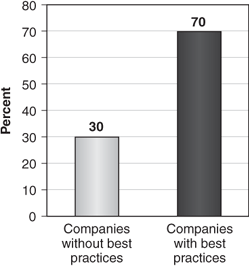The Key Alliance Success Factors
We are aware that alliances have a bad reputation in some circles (see Exhibit 10.10). Studies across a broad range of industries have reflected a mixed record, with average success rates of only 50%. Success here is defined as meeting alliance objectives (usually financial), enhancing competitive position, and achieving certain levels of partner harmony. However, the real story is the disparity between those companies that have installed an alliance “best practices” program and those companies without such formal programs. Using best practices in forming and operating alliances more than doubles the average success rate.[9]
[9] The Warren Company, 1994–2001; Booz-Allen Hamilton, 2000; BYU-Wharton Study, 2001.
Exhibit 10.10. Alliances with “Best Practices” Programs Have a Much Higher Success Rate Than Those Without
Sources: Booz-Allen Hamilton, The Warren Company, BYU-Wharton Study.

As a business form, alliance return on investments were significantly higher than industry-average performance and are growing dramatically as contributors of top-line revenue, estimated to be around one third of total revenues by the end of 2005. Our own business is not so formalized in codifying its alliance practices, but after 19 years and over 30 alliances, the basic culture and learned behavior of our organization is highly developed in alliance best practices. ...
Get Innovate or Perish: Managing the Enduring Technology Company in the Global Market now with the O’Reilly learning platform.
O’Reilly members experience books, live events, courses curated by job role, and more from O’Reilly and nearly 200 top publishers.

